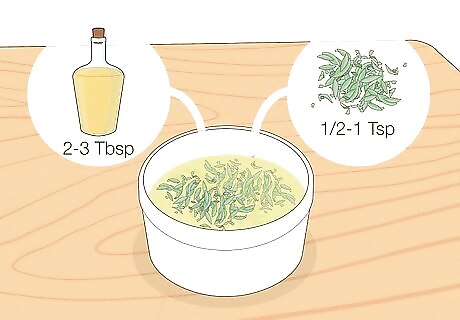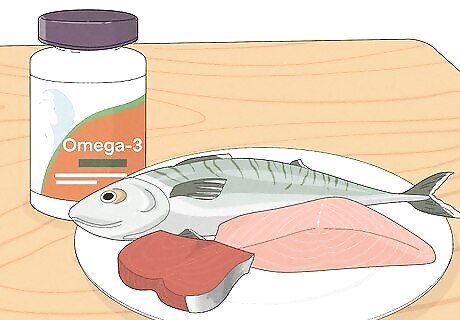
views
X
Research source
Treating Lipomas with Natural Oils and Herbs

Create an ointment using natural oils and herbs. Natural oils such as neem and flaxseed make excellent base for ointments. Experiment with different combinations of herbs and oils. Neem oil is an astringent that helps protect your skin. It is commonly used in Ayurvedic (ancient Indian) medicine to treat lipomas. Flaxseed oil has high levels of omega-3 and omega-6 fatty acids. Omega-3 and omega-6 fatty acids help to reduce inflammation. Be sure to buy flaxseed oil certified to be free of heavy metals, such as lead and mercury.Tip: While not a natural oil, cooled green tea is a great alternative for your base. It is high in antioxidants that help regulate blood sugar and blood fats.

Mix chickweed with a natural oil or tea base. Blend 1 teaspoon of chickweed with 2-3 tablespoons of neem oil or flaxseed oil. Apply the salve to the lipoma. Chickweed is used to reduce fats. Or, use 1-2 tablespoons of cooled green tea instead of neem or flaxseed oil to make a paste.

Try creating an ointment with turmeric. Mix 1 teaspoon of turmeric with 2-3 tablespoons of neem oil or flaxseed oil. Smooth the ointment onto the lipoma. Your skin will turn a bit orange or yellow because of the turmeric. Cover the lipoma with a bandage to protect your clothes. Turmeric, like neem oil, is commonly used in Ayurvedic medicine. For a paste, add 1-2 tablespoons of cooled green tea instead of neem or flaxseed oil to the turmeric.

Add dried sage to neem oil or flaxseed oil. Mix ½ to 1 teaspoon of dried sage with 2-3 tablespoons of neem oil or flaxseed oil. Coat the lipoma with the balm. Substitute 1-2 tablespoons of cooled green tea for neem or flaxseed oil to make a paste. Sage is used in traditional Chinese medicine to dissolve fatty tissue.
Making Dietary Changes

Increase the amount of vegetables and fruits in your diet. Fruits and vegetables have antioxidants which help lower fats in the blood. Choose brightly colored fruits and vegetables for the highest level of antioxidants. Some great examples of fruits and vegetables high in antioxidants are blueberries, raspberries, apples, plums, citrus fruits, leafy green vegetables, squash, and bell peppers.

Eat more fish. Fish has good amounts of healthy omega-3 fats and quality protein. Omega-3 fats help to decrease inflammation and may help limit the growth of lipomas. Salmon and tuna are excellent sources of omega-3 fatty acids and are high in protein. Good sources of omega-3 fatty acids which are also high in vitamin B-12 include mackerel, herring, and trout.

Limit your red meat consumption. If you do eat red meat, make sure it is grass-fed with no added antibiotics or hormones. Grass-fed meat has a lot of healthy omega-3 and omega-6 fats. Chicken, tofu, and beans are all healthy alternatives to red meat that are also high in protein.

Switch to organic foods as much as possible. Switching to organic foods reduces the number of preservatives and additives you eat. Your liver will then be able to focus on removing the toxins stored in the lipoma’s fatty tissue.Did You Know? Limiting the amount of processed and pre-packaged foods you eat will also limit the amount of additives and preservatives in your diet.
When to Seek Medical Treatment

See a doctor if you feel pain or discomfort, have a new lump, or see swelling. It’s possible for a lump to look like a lipoma but really be something else. Since lipomas aren’t painful, experiencing pain might be a sign that your lump is something else. Similarly, it’s best not to try treating a new lump or an area of swelling until you’ve had it checked by a doctor. Your lump is most likely not a cause for worry, but it’s good to be sure that it’s a lipoma rather than something else.

Expect your doctor to do a tissue biopsy and an X-ray, MRI, or CT scan. These tests will help your doctor make sure what you have is really a lipoma. In most cases, your doctor will do your diagnostic tests quickly in their office. You shouldn’t feel any pain when your doctor takes a biopsy, but you may experience discomfort. Before taking a biopsy, your doctor will numb the area around the lipoma. Then, they’ll use a thin needle to take a small sample from the lump. Finally, they’ll examine the sample under a microscope to make sure it’s a lipoma. X-ray, MRI, and CT scans are all imaging tests. In most cases, your doctor will just do one of them. An X-ray can show a shadow where the lipoma is located, while an MRI and CT scan can show the lipoma in more detail.

Ask your doctor if liposuction can treat a lipoma that’s bothering you. If you have a small lipoma that is interfering with your daily life, your doctor may be able to remove it using liposuction. To do this procedure, your doctor will administer a numbing agent near the lipoma so you won’t feel pain. Then, they’ll use a needle to suck out the fatty tissue in the lipoma. This simple procedure is quick and doesn’t require much recovery time. However, you might experience soreness, discomfort, and bruising.

Consider surgical removal if the lipoma restricts your movement. If your doctor thinks surgery is the right option for you, they’ll usually sedate you before surgery. To remove the lipoma, they’ll make a small incision and then extract the lipoma from your body. Finally, they’ll stitch up the incision. After surgery, you may have some scarring around the area. However, the scar likely won’t be very noticeable. Additionally, discomfort and bruising are common in the days after surgery. You might also consider surgery if the lipoma is affecting how you feel about your appearance.Tip: If you get your lipoma surgically removed, it’s very unlikely that it will come back.




















Comments
0 comment